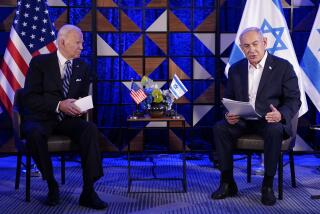ASIA : U.S.-Japan Trade: Itâs Time to Share
Now that Congress has debated the possibility of an endless Bosnian quagmire, what the United States needs is an exit strategy from the Cold War in Asia. The outmoded U.S.-Japan alliance and increasingly contentious relations with China generate trade, technology and defense asymmetries every bit as critical to the nationâs future as the threat of casualties in Europe. Whatâs needed is an economic and security regime for current realities.
Thatâs the message of a new, but largely ignored report on U.S.-Japan security by the National Research Councilâs Defense Task Force, a team of university, public-policy and private-sector experts who evaluated the security consequences of U.S. science and technology policies toward Asia. The report describes how U.S. strategic thinking in the region is built around maintenance of an unbalanced security relationship with Japan--a situation that, ironically, could generate exactly the explosive conflicts both nations want to avoid.
During the Cold War, profound differences between U.S. and Japanese strategic ambitions were overshadowed by a common Soviet threat. Thanks to U.S. military protection, Japan was able to pursue a mercantilist security policy. Amassing weaponry and pursuing an independent foreign policy were less important than creating national technological and economic advantage.
The United States, by contrast, subordinated technology and economic concerns to âpureâ defense considerations such as troop deployments. Unlike Japan, it traded technology that helped educate and enrich foreign manufacturers to shore up its military alliances.
Until recently, U.S. strategy meshed perfectly with Japanese ambitions. Japan bowed to American interests in exchange for one-way, inbound technology flows and U.S. military protection. Under such circumstances, the U.S.-Japan alliance became the linchpin of Asian security.
All this can unravel--and fast. Lacking an overriding threat, and in an era when Japanese technology capabilities are incomparably more advanced than at the time the alliance was formed, long-repressed resentment in both countries could erupt at the slightest provocation.
Japanese political subservience may have been crucial during the Cold War, but it comes at a technological price hard to justify today. According to the task force, Japan imports eight times the amount of technology it sends to the United States each year; it dispatches 15 times more technical personnel than go to Japan. This feeds a $43-billion technology-intensive merchandise trade deficit.
If both countries believed their oft-repeated sentiment that the U.S.-Japan relationship is âthe most important bilateral alliance in the world, bar none,â they would never have allowed it to languish unadjusted for decades. Instead, they would have formed a reciprocal and multilateral agreement responsive to the dramatic changes in regional power that have occurred in the last 40 years--including an explicit recognition of the Asiawide, rather than bilateral, security role now played by U.S. troops in Japan.
Many officials in Washington, Tokyo, Seoul and even Beijing, in fact, agree that the U.S. regional presence is critical. Privately, however, they admit that a reassessment of U.S.-Asian alliances is long overdue. Yet, not only has no one even begun to think about this, but American planners keep repainting the rusting chassis of the cornerstone U.S.-Japan bilateral relationship and insist itâs suitable for the high-speed maneuvers the next century will demand.
This is wishful thinking. Differential technological and economic benefits alone can cause a crash.
Over the last 20 years, the task force found that the two countries have not come close to balancing their military or dual-use technology exchanges, despite numerous, high-profile initiatives designed to do so. Since the 1970s, Japanese firms have been obliged to âflowbackâ technological improvements as a condition of receiving U.S. technology licenses. In the early â80s, Japan promised to send certain defense-applicable technologies to the United States, despite self-imposed restraints against military exports.
In practice, however, Japanese firms still avidly resist technology transfers--often citing the same restrictions supposedly eliminated years ago. Nor have âjoint developmentâ projects such as the FS-X jet-fighter program resulted in much technological benefit to U.S. manufacturers. Most recently, Sharp, a major Japanese flat-panel-display maker, declined to license its technology to the Pentagon, leading Washington to mount a domestic development program at great cost to U.S. taxpayers.
This is consistent with the security philosophy Japan honed during the Cold War, but Washington has shown little stomach to press for a better alternative. The Clinton administration arrived with a freshly minted âTechnology for Technologyâ policy targeting Japan. Two years later, Defense Secretary William J. Perry, the original architect of the policy, officially âdelinkedâ the effort from key co-development projects, including a major missile-defense effort, when Japan balked at the approach.
Pressing for balance in the U.S.-Japan alliance is particularly important because public resentment over one-sided technology exchanges, and concerns over military-technology proliferation and foreign dependence, are already helping foster an isolationist backlash in America. The illogic of basing U.S. troops in Japan without a broad, regionwide security rationale breeds rancor in Asia, as the outrage following the rape of a Japanese schoolgirl by U.S. soldiers in Japan shows. Feeding on such ill will, nationalist politicians in the United States and Asia could create a crisis that would leave America with neither allies nor influence in the worldâs most populous--and soon to be richest and most innovative--region.
The National Research Councilâs task force outlines a more promising approach. The new foundation of a U.S.-Japan alliance, it suggests, should be recoupling U.S. economic and security interests in Asia. For its part, Washington must prepare to learn about and exploit the technology and know-how Japan has to offer; the Japanese must moderate their historical strategies and show they can, in fact, share their knowledge.
One place to start, the task force suggests, is with the Theater Missile Defense project, a complex and controversial effort to which both the United States and Japan could contribute a combination of operational and R&D; resources. The Japanese should be expected to ante up with technology if they are to participate in joint development. Otherwise, Washington should insist that Japan buy the missile project off the shelf.
A far more desirable and ambitious goal would be to expand the bilateral alliance into a regionwide security organization that recognizes each participantâs economic and technology interests, as well as its legitimate military concerns. Accomplishing this objective, however, means each country must shed its Cold War mentality. Above all, it means carefully, but firmly re-engaging the United States in Asia on terms offering clear benefits that U.S. citizens will embrace.
The U.S.-Japan security alliance is indeed the key to Asia, but its mounting pathologies, if not treated soon, could produce an unhappy regional outcome. Major powers like China, for example, are pursuing mercantilist technology and trade strategies eerily reminiscent of Japanâs, largely because Washington has failed completely to offer a credible alternative. Others, such as South Korea, would welcome a stable regional order that encompasses China and balances Japanese power without having to depend entirely on the presence of the increasingly unpopular, uniformed U.S. troops strolling in downtown Seoul.
We are understandably fearful of a Vietnam-like result in Bosnia, but exiting from the Cold War in Asia may well be a far greater security challenge. Washington should begin now to imagine a post-Cold War Asia where the burdens and benefits of creating wealth and security are distributed cooperatively and equally--or it may one day discover that such a result is no longer possible.
More to Read
Sign up for Essential California
The most important California stories and recommendations in your inbox every morning.
You may occasionally receive promotional content from the Los Angeles Times.










